 |
 |
 |
| |
ARTS 4 Days A Week Instead of 7, not good, Jules. - "ANRS 170 QUATUOR 4/7 days maintenance strategy in antiretroviral treated adults with HIV-1 infection: an open randomised parallel non-inferiority phase III trial"
|
| |
| |
Online IAS HIV reporters & tweeters have been reporting this study presented at IAS in a bad light as I see it, they have hyped this up & reported this as if 4 days a week appears good & preferable, because the 4 day a week treatment group % undetectable was non-inferior vs the 7 days a week. However there are several key reasons to question these study results, or at least to be circumspect or skeptical about this study result that the reporters & tweeters fail to discuss these: 1 - its a 48 week study and long term viral failures may occur, 2 - its a study, not real world where non adherence or inadvertent missed doses may occur increasing the risk for viral failure & resistance developing, AND it may be more difficult for all HIV to remember taking ARTs 4 days a week, its often easier to realize you take these drugs every day, a routine makes a big difference ; there is little room for mistakes with 4 days & little room for individual drug levels differences; 3 - there were 6 viral failures in this study in 4 day group vs 4 in 7 day group. I knew years ago interrupting therapy was a big mistake despite being pushed by man, this is similar. Another possible issue is what is the affect of on & off therapy on reservoirs, on brain function, CVD, are there viral blips - we don't know the answers to these, its easy for "reporters" to promote the outcome without considering the real concerns. Jules, NATAP
ANRS 170 QUATUOR 4/7 days maintenance strategy in antiretroviral treated adults with HIV-1 infection: an open randomised parallel non-inferiority phase III trial
Reported by Jules Levin
IAS 2019 Mexico City July 22-25
R. Landman1,2, P. De Truchis3, L. Assoumou4, S. Lambert5, K. Amat2, J. Bellet4, B. Lefebvre6, C. Allavena7, C. Katlama8, Y. Yazdanpanah1, J.-M. Molina9, A. Gelley10, S. Gibowski10, J.-C. Alvarez11, L. Morand-Joubert5, D. Costagliola4, P.-M. Girard4, ANRS 170 QUATUOR study group
Institutions
1IAME, UMR 1137, INSERM, Universite Paris Diderot, Sorbonne Paris Cite, AP-HP, Hopital Bichat, AP-HP, Infectious and tropical diseases, Paris, France, 2Institut de Medecine et Epidemiologie Appliquee, Hopital Bichat, Universite Paris 7, Paris, France, 3Hopitaux Universitaires Paris-Ile de France-Ouest, Hopital Raymond Poincare APHP, Universite Versailles-Saint-Quentin, France, Infectious diseases department, GARCHES, France, 4Sorbonne Universites, INSERM, UPMC Univ Paris 06, Institut Pierre Louis d'Epidemiologie et de Sante Publique (IPLESP UMRS 1136), Paris, France, 5Hopital Saint-Antoine, Laboratoire de virologie, Paris, France, 6Hopital Saint-Antoine, Infectious diseases department, Paris, France, 7Hopital Hotel-Dieu, Infectious diseases department, NANTES, France, 8Hopital Pitie-Salpetriere, Infectious diseases department, Paris, France, 9Hopital Saint-Louis, Infectious diseases department, Paris, France, 10ANRS, France REcherche Nord & sud Sida-hiv Hepatites, Agence autonome de l'INSERM, Paris, France, 11Hopital R Poincare APHP, Inserm U-1173, Universite Paris-Ile de France Ouest, Pharmacology department, GARCHES, France
Background: Intermittent treatment could improve the convenience, tolerability and cost of ART. We have previously shown a 96% success rate of a maintenance 4 days a week (4/7 days) antiretroviral strategy in the ANRS 162 4D pilot study. The current study was designed to demonstrate the non-inferiority of this strategy versus 7/7 days in patients with controlled viral load (VL) under triple therapy with either PI, NNRTI, or InSTI based regimen.
Methods: We conducted an open-label, randomised, multicentric, non-inferiority phase III trial evaluating efficacy and safety of a maintenance 4-days a week therapy (4/7 days) versus current triple ART regimen (CAR). Adults with plasma VL< 50 copies/mL for >12 months and no resistance mutations to CAR were randomly assigned (1:1) with stratification by third-agent class. The primary endpoint was the Kaplan-Meier estimated proportion of participants with treatment success (VL< 50 copies/mL and no treatment strategy modification) at week 48 among those starting the study strategy. We calculated the Cochran-Mantel-Haenszel treatment difference adjusted for the stratification factor, with a 5% non-inferiority margin. ClinicalTrials.gov: NCT03256422.
Results: Participants were screened from Sep 7, 2017, to Jan 22, 2018. Among 647 randomised participants, 636 were included in the modified intent-to-treat analysis (318 in each arm).
At entry, median age was 49 years (IQR 41-55), 85% were male, with VL< 50 copies/ml for 5.8 (3.3-9.6) years, median CD4 689 (533-884) cells/mL; NRTI: 56.3% TDF/FTC, 16.3% TAF/FTC, 27.4% ABC/3TC; 3rd agent: 6% PI, 46% NNRTI, 48% InSTI. At week 48 (last patient visit was April 4, 2019), the treatment success rate was 95.6% in the 4/7 days arm vs 97.2% with CAR (adjusted difference of -1.6%, 95% CI -4.5% to 1.3%), demonstrating the non-inferiority.
Six (1.9%) and 4 (1.3%) participants experienced virological failure with selection of resistance mutations in 3 and 1, respectively. No difference in adverse events was observed between the two arms. A moderate improvement of eGFR was observed in the 4/7 days arm, +5.5[-1.2-+13.6] ml/min vs +1.3[-6.1-+7.5] ml/min in CAR, P< 0.001.
Conclusions: The ANRS 170 QUATUOR randomised trial demonstrates the non-inferiority of a 4/7 days maintenance strategy vs a 7/7 days regimen.
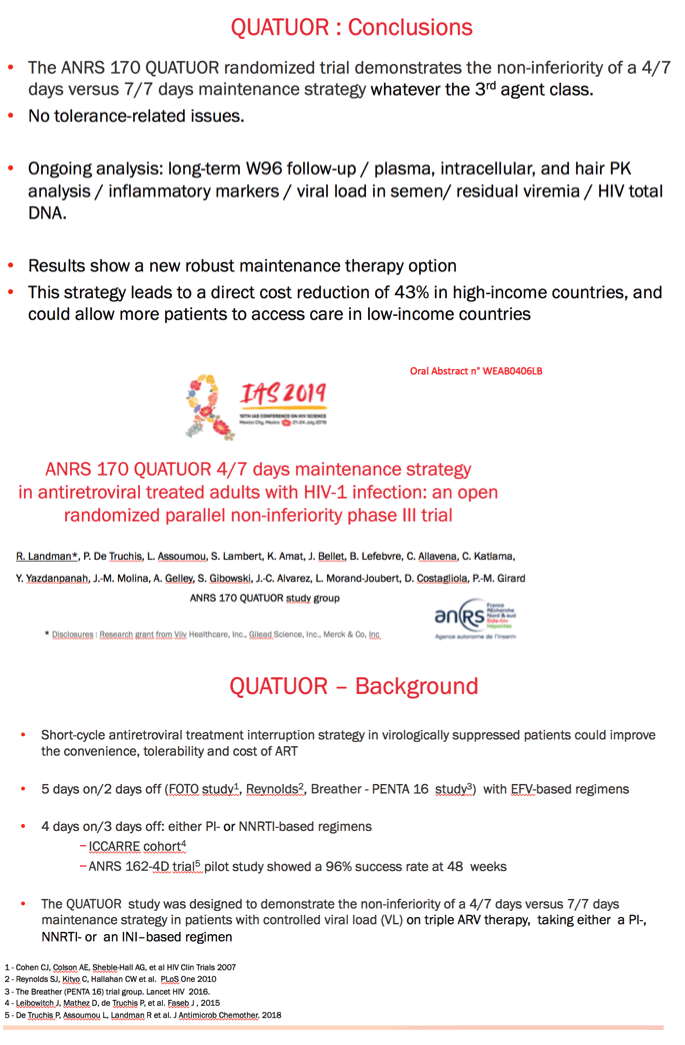
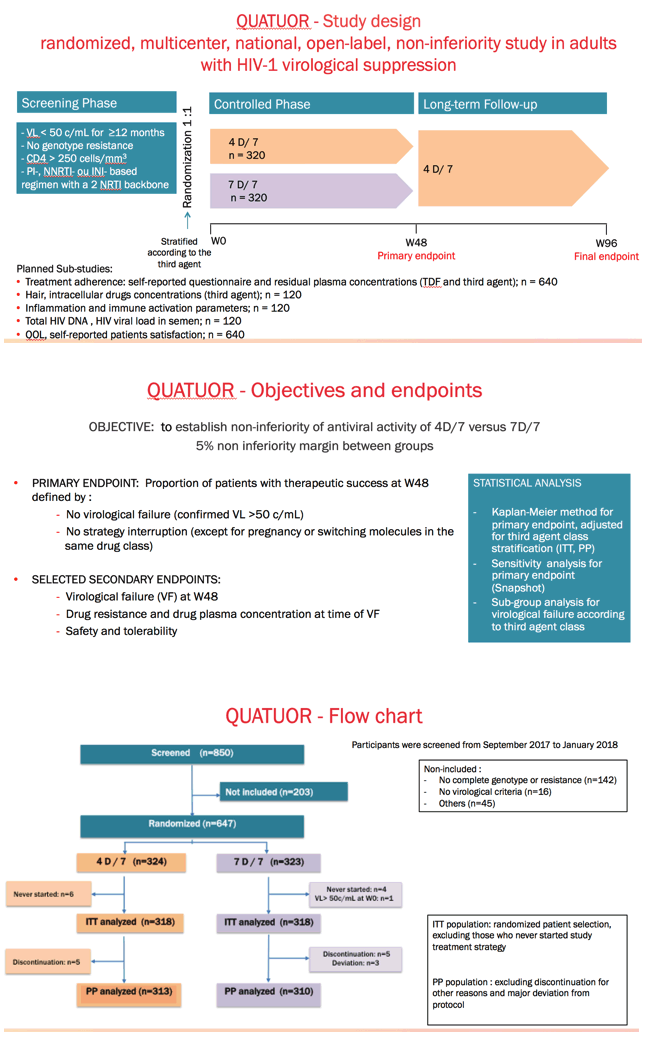
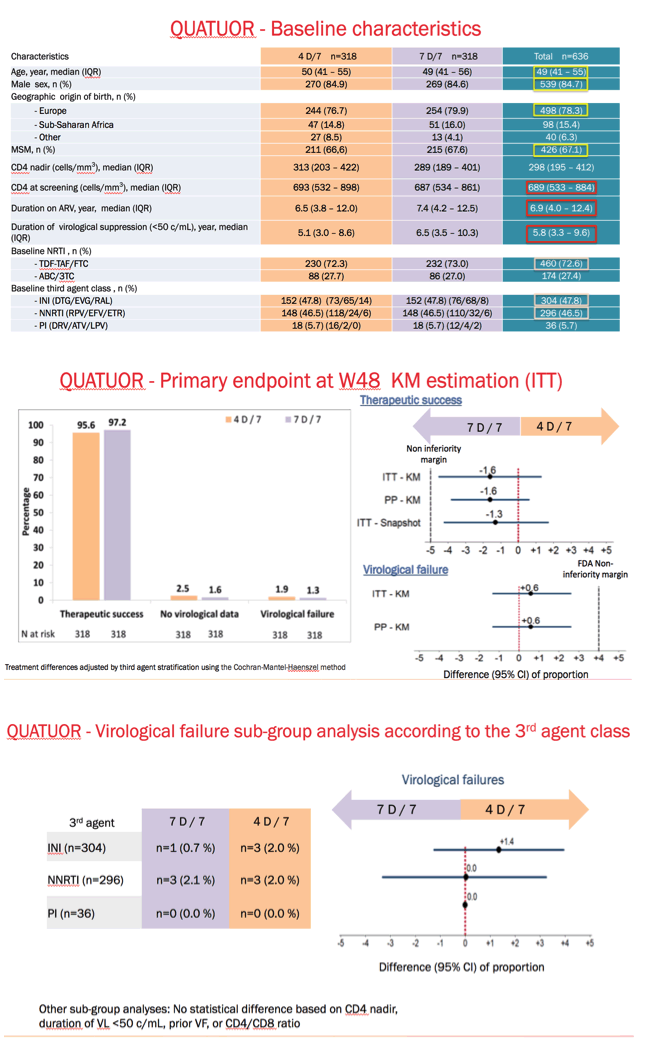
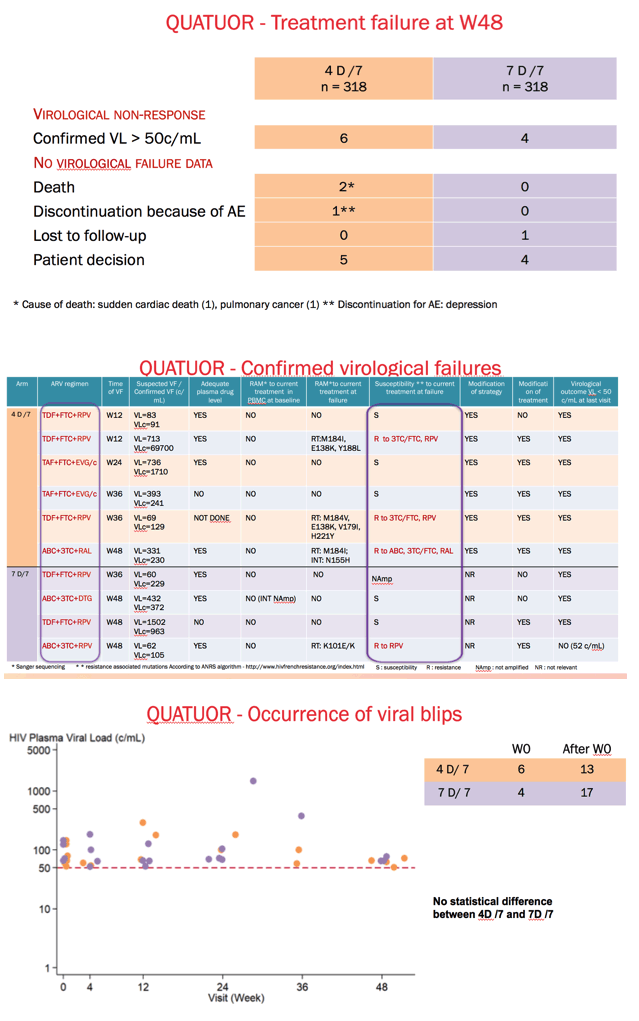
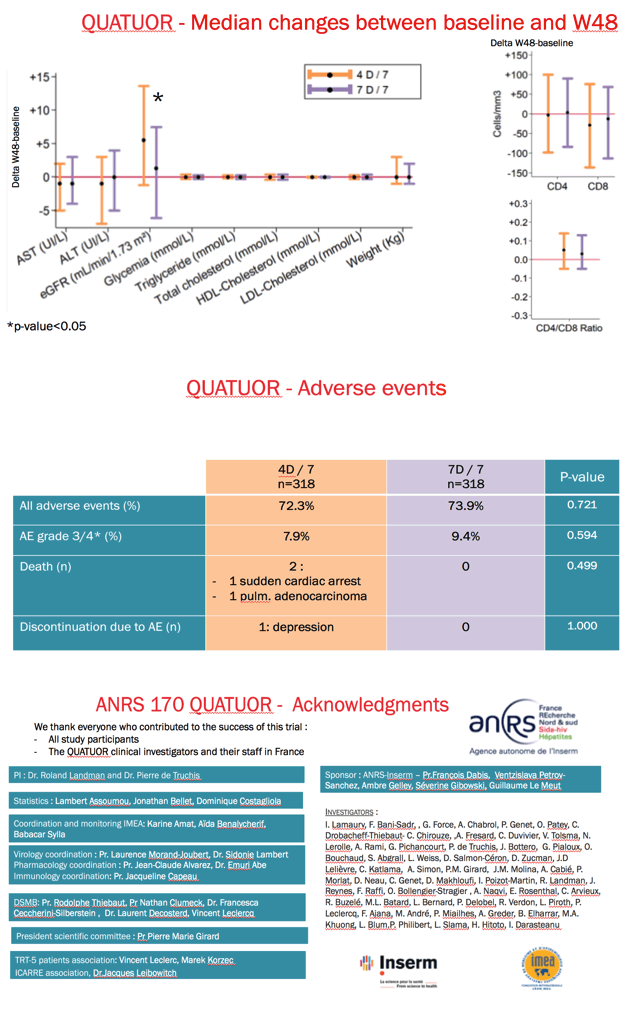
|
| |
|
 |
 |
|
|